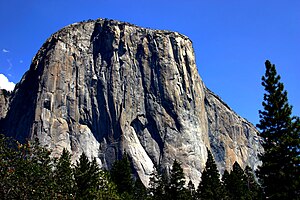Salathé Wall
| Salathé Wall | |
|---|---|
 Southwest face of El Capitan from Yosemite Valley | |
| Location | California, USA |
| Coordinates | 37°44′02.4″N 119°38′13.2″W / 37.734000°N 119.637000°W |
| Climbing Area | Yosemite Valley |
| Route Type | Aid climbing, Free climbing |
| Vertical Gain | 2,900 ft (884 m) |
| Pitches | 35 |
| Rating | 5.13b or 5.9 C2 |
| Grade | VI |
| First ascent | Royal Robbins, Tom Frost, and Chuck Pratt, 1961 |
| First free ascent | and Todd Skinner, 1988 |
The Salathé Wall is one of the original technical climbing routes up El Capitan, a 3,000-foot (900 m) high granite monolith in Yosemite National Park. The Salathé Wall was named by Yvon Chouinard in honor of John Salathé, a pioneer of rock climbing in Yosemite. The route is recognized in the historic climbing text Fifty Classic Climbs of North America and considered a classic around the world.[1][2] Due to its length, difficulty, rock quality and variety of climbing, it is often called the world's "greatest" rock climb.

It was first ascended in 1961 by Royal Robbins, Tom Frost and Chuck Pratt. After climbing about a quarter of the route, they retreated to re-supply, leaving four fixed ropes in place. Quickly returning, they jumared back up the ropes and totally committed to climbing the upper wall in a single push, which they did in 6 days using only 15 bolts total. The route was about 25% free climbing with sections of run-out 5.9, and the direct aid was also difficult (A4). A year later, Robbins and Frost returned and did the route in a single push from the bottom.
Peter Haan in 1972 was the first to climb the route alone, using pitons for aid and protection.
In 1975 Kevin Worral and Mike Graham, starting from the Nose route, free climbed (at 5.11) seven pitches of this route to Mammoth Terraces. A few days later, Jim Bridwell, John Long, John Bachar and Ron Kauk free climbed the first three pitches (5.11) of this route. The ten free pitches combined are commonly known as "Free Blast".[citation needed]
Todd Skinner and Paul Piana were the first to free climb all the sections of this route during a nine-day push in 1988, after thirty days of working the route (graded 5.13b by the Yosemite Decimal System).[3] This was the first major El Capitan route to be free climbed. In 1995 Alexander Huber was the first person to make a continuous free ascent, leading every pitch free himself. Its first female ascent was by Steph Davis in 2005.[4]
References[]
- ^ Roper, Steve; Steck, Allen (1979). Fifty Classic Climbs of North America. San Francisco: Sierra Club Books. pp. 269–275. ISBN 0-87156-292-8.
- ^ McNamara, Chris, and Sloan, Erik. Yosemite Big Walls. Mill Valley, CA: SuperTopo, 2005. ISBN 0-9672391-9-2
- ^ Samet, Matt; Steve Bechtel (November 2006). "Loss of a Legend". Climbing Magazine. Primedia. Retrieved 2007-03-27.[dead link]
- ^ Noble, Chris (2013), Women Who Dare: North America's Most Inspiring Women Climbers, Falcon Guides, Globe Pequot, p. 27, ISBN 9780762783717.
External links[]
- Climbing routes
- Yosemite National Park
- Climbing stubs
